Our species has grown from Homo heidelbergensis to modern Homo sapiens. This journey has been filled with amazing adaptations and technological leaps. From starting to farm to using the latest tech, we’ve left a lasting impact on Earth. But, how will we be seen in the far future?
Future archaeologists will use Future Archaeology to study our civilization’s leftovers. They’ll uncover how we lived, worked, and succeeded. They might even predict how we’ll change physically in a crowded world. The mix of biology and tech could make Cultural Heritage Preservation very challenging.
Looking ahead a million years, our legacy depends on today’s choices. How we use tech, keep our culture alive, and adapt to Earth’s changes will shape our future memory. Our evolution story is ongoing, and our choices today will influence what our descendants will see.
Introduction to Future Archaeology
Future Archaeology is a new field that mixes old ways of studying the past with new tech. It looks at how our actions and things we make today will be seen by people in the future. This new way of thinking helps us understand how to leave a good mark on history.
Definition and Importance
Future Archaeology is about looking ahead to see what might be important in the future. It uses computers and data to guess what sites and things might be found by future archaeologists. It’s key in showing how Digital Humanities and Computational Anthropology help keep our mark on Earth.
How It Differs from Traditional Archaeology
Future Archaeology is different because it looks to the future, not just the past. It uses new tools like satellite pictures and models to guess where important sites might be. This way, we can plan ahead to keep our legacy safe for others to study.
“The future has seldom been an object of archaeological study, despite profound links between past, present, and future.”
By linking the past, present, and future, Future Archaeology helps us make better choices. It gives us a chance to shape the world we’ll leave behind. As we face today’s challenges, this field offers a fresh view on our lasting impact.
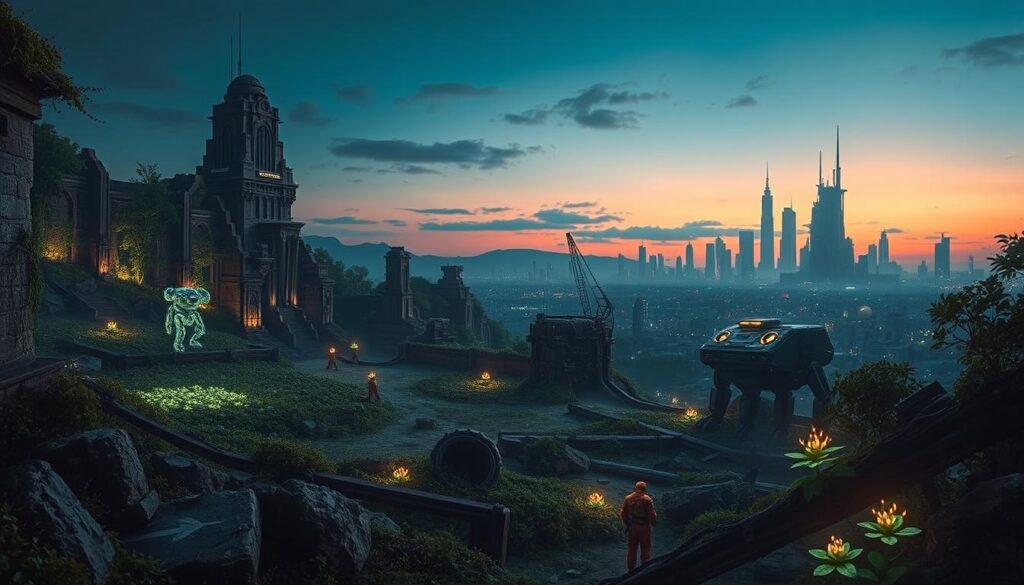

The Role of Technology in Preservation
Technology is key in keeping human history alive for future generations. Archaeological Informatics and Data-Driven Archaeology help us uncover the past like never before.
Digital Records and Their Longevity
Today, we create a lot of digital data, from social media to documents. But keeping this data safe for the long term is hard. New tech like DNA data storage and quantum memory might help.
These technologies could keep our digital history safe for millions of years. This would let future people understand our lives and times with great clarity.
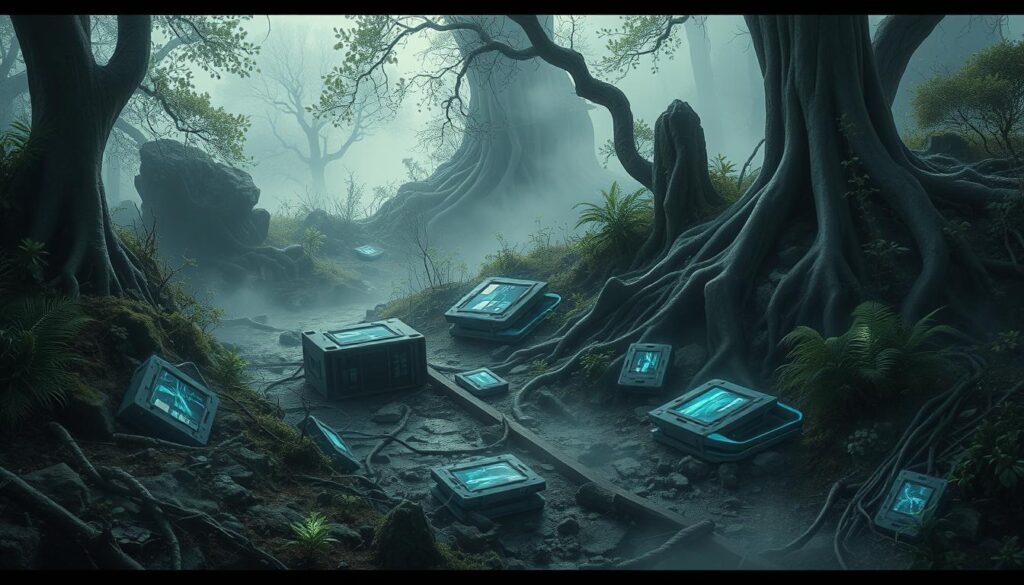

Advances in Storage Solutions
As we move into the digital age, finding good storage is crucial. New tech like DNA data storage and quantum memory might solve this problem. They use DNA or quantum physics to keep our digital data safe.
This tech could make sure our digital history stays accessible for a long time. It will help Archaeological Informatics and Data-Driven Archaeology reveal more about our past.
“The Fourth Industrial Revolution is upon us, and the integration of technology into every aspect of our lives is profoundly shaping the future of archaeology.”
What Will Remain of Our Cities?
Future archaeologists will find a rich mix of urban remains when they explore our cities. They will see how buildings stand strong against time. This will give us a deep look into how our society has evolved.
Urban Structures and Their Durability
Our cities are made of strong materials like concrete and steel. This makes them last longer than ancient ruins. For example, Rome has hidden layers built over 28 centuries, and London has sunken areas nearly 10 meters deep.
Even cities like Seattle, rebuilt after fires, show how buildings can endure. Seattle was raised on walls, despite losing 17 people during the process.
The Impact of Climate Change
But, climate change might change how our cities last. Rising seas and extreme weather could damage buildings. For instance, Fukushima’s cleanup shows how nature affects our creations.
Archaeologists might find both well-kept ruins and changed landscapes. These will show how our culture and climate have evolved. They will help us understand human resilience and adaptability.
“The archaeological record reflects human culture through the objects and materials left behind, not just the materials themselves.”


Artifacts of Our Time
Future archaeologists might find a wealth of everyday items that tell us a lot about our Cultural Heritage Preservation and Futuristic Heritage Studies. They could find smartphones, plastic products, and synthetic fabrics. These items might show us what technology, habits, and values were important in our time.
What Everyday Items Will Be Discovered?
Imagine archaeologists finding old smartphones. These devices were once full of information, communication, and fun. They could show how fast technology changed our lives. Also, plastic packaging and synthetic fabrics might show how much we used non-biodegradable stuff and its effect on the environment.
Significance of Cultural Artifacts
Art, literature, and religious symbols are also important. They could help future civilizations understand our beliefs, social structures, and creativity. These artifacts might give a peek into our shared human experiences, helping future generations connect and learn from us.
“The preservation of our cultural heritage is not just about safeguarding the past, but about shaping the future. The artifacts we leave behind will be the legacy we pass on to those who come after us.”
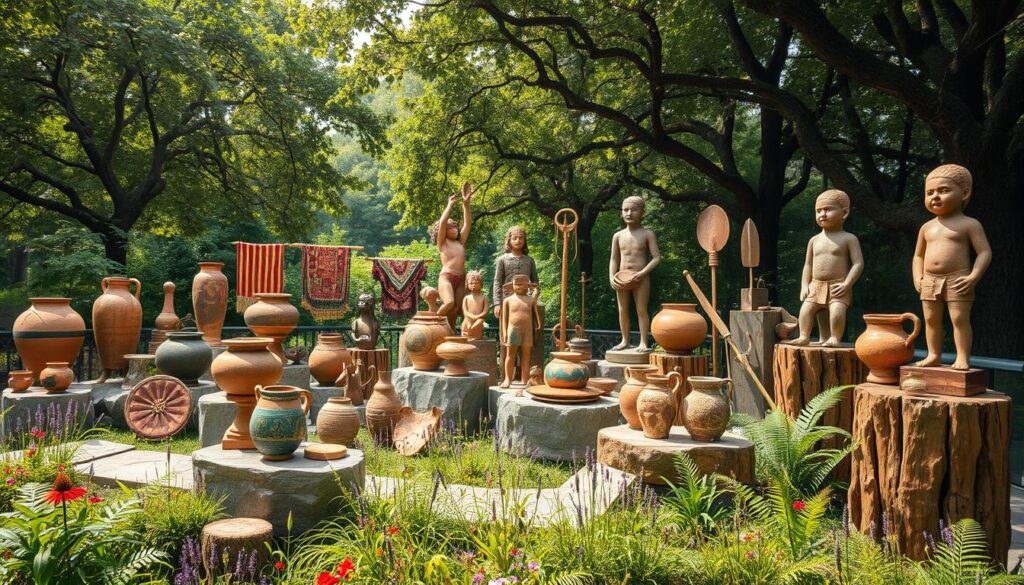

As we live in today’s world, thinking about what we leave behind is key. By focusing on Futuristic Heritage Studies, we can make sure our legacy shows the full range of our culture. This way, future generations will be inspired to value and protect our rich human history.
Language and Communication
Over a million years, our communication methods could change a lot. The Digital Humanities and Computational Anthropology give us clues about these changes. They show how language and writing might look in the future.
How Language Evolves Over Time
Language changes a lot because of culture, society, and technology. As time goes on, dialects and new ways to express ourselves can make languages different. Future archaeologists might use special tools to understand our language.
The Future of Written Records
Keeping written records, digital and physical, is key to our culture and language. New tech like brain-computer interfaces could change how we write and store info. Future experts will use Digital Humanities and Computational Anthropology to keep our records safe.
“The future of language and communication is both exciting and challenging. As we continue to evolve, the ability to bridge the gaps between past, present, and future will be critical in shaping our shared legacy.”
The journey ahead is full of unknowns. But, Digital Humanities and Computational Anthropology give us hope. They help us keep and understand our language and culture for future generations.
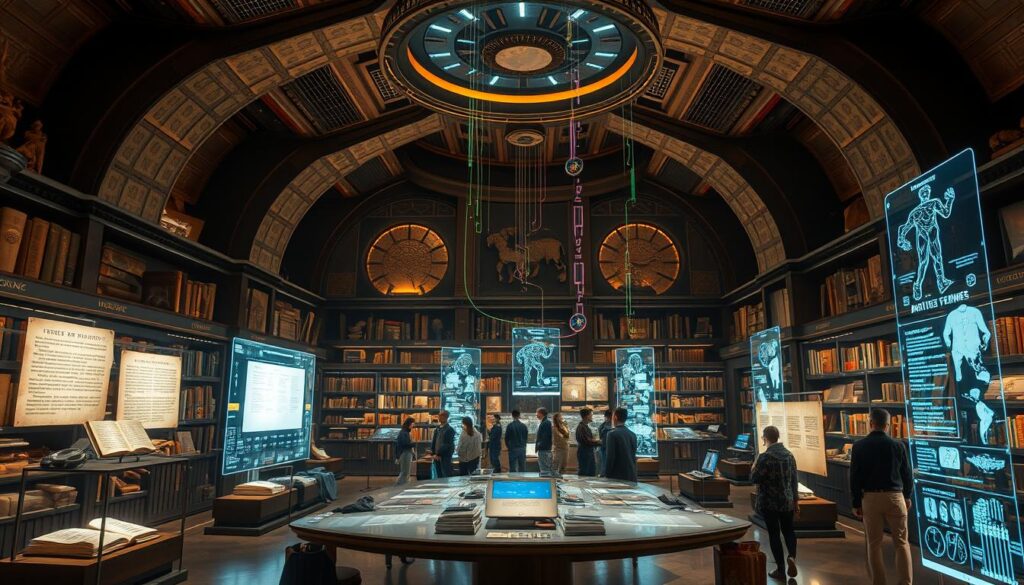

Studying Human Behavior
The digital age has changed how we study human behavior. Social media platforms now hold a vast amount of data. This data gives future archaeologists a unique look into our society’s patterns and trends.
By using Data-Driven Archaeology, researchers can find valuable insights in our online interactions. They can learn about our social connections and cultural expressions.
Insights from Modern Social Media
Social media platforms like Facebook, Twitter, and Instagram reflect our daily lives. They generate a lot of data on how we communicate and share ideas. Future archaeologists will use Anticipatory Analysis to uncover stories in this digital world.
They can analyze our posts and social connections to understand human behavior in the digital age. This data shows how culture changes, language evolves, and how we adapt to new technologies.
Future Archaeologists and Human Trends
Future archaeologists will face the challenge of understanding this vast digital data. They must deal with biases and distortions in online data. They need to understand historical context to make accurate conclusions about human behavior.
By combining social media insights with traditional methods, researchers can get a full picture of human history. They can track cultural origins and predict future trends. The use of Data-Driven Archaeology and Anticipatory Analysis will be key in understanding humanity.
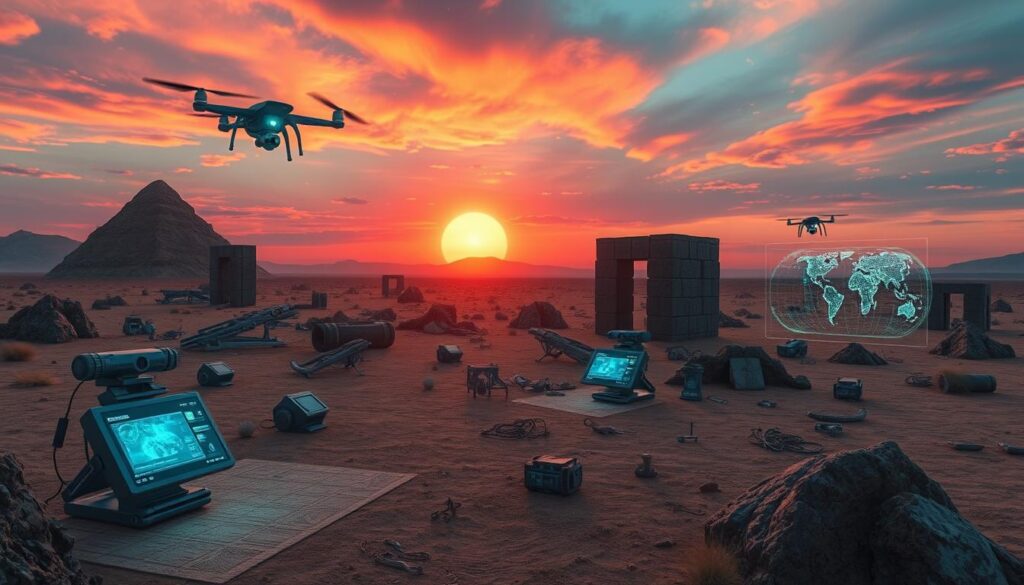

Environmental Changes and Their Impact
Human history is written in the Earth’s layers, showing our growth and culture. Future archaeologists will find clues about our environmental impact. They will see how plastics, pollutants, and climate changes mark our time, known as the Anthropocene.
The Geologic Record of Human Activity
Layers of sediment will hold secrets of our industrial past. Researchers will find pollutants, plastics, and more, showing our Predictive Modeling effects. This record will reveal our energy use, policies, and Techno-Cultural Evolution.
How Pollution Shapes the Future
- Global temperatures could jump from +2.6 to +4.8 °C by 2100, a study says.
- Carbon levels in the air have been going up, with 2017 data showing a steady rise.
- Archaeologists stress keeping artifacts safe from climate change, like in the Mississippi River basin.
Pollution, climate change, and resource use are changing our planet. Future archaeologists will learn a lot from this. This knowledge could help us understand the past and build a better future.
“The rise of archaeology in fighting climate change is now more important than ever. It helps preserve our history and teaches us for today’s challenges.”
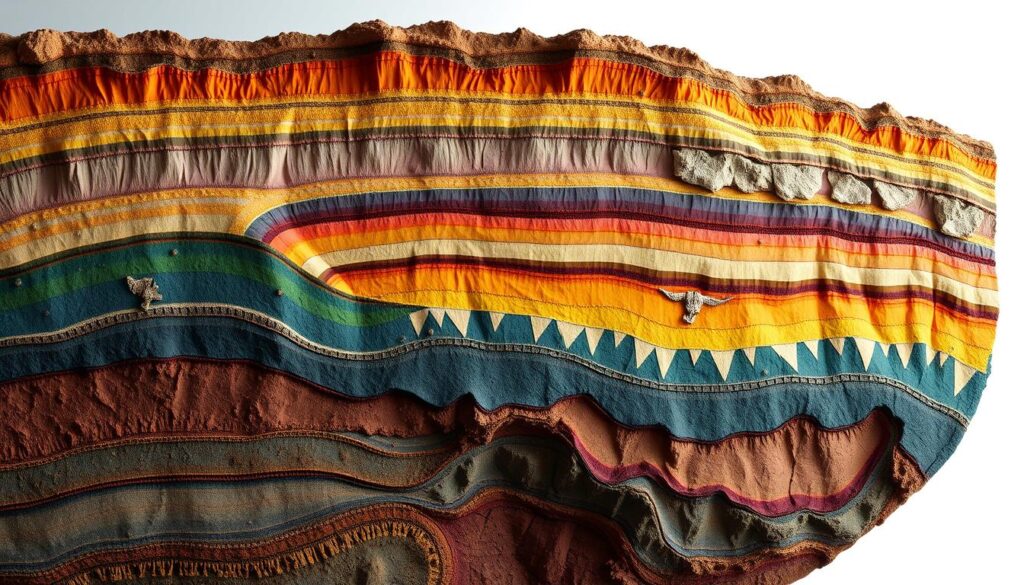

Predicting Future Archaeological Sites
Looking ahead, archaeological informatics gives us clues about where future archaeologists will find our civilization’s past. They study land use and environmental factors to predict sites. These sites could reveal a lot about Futuristic Heritage Studies.
Urban vs. Rural Areas
Urban areas are expected to be treasure troves for archaeologists. They have lots of human activity and buildings that hold secrets. These secrets could tell us a lot about our society.
Rural areas, on the other hand, might show us how people lived with nature. They could reveal how our relationship with the environment has changed over time.
Potentially Significant Locations
- Places like famous landmarks, museums, and historic sites will likely interest future archaeologists.
- Areas of new technology, like Archaeological Informatics, could also be important.
- Locations of big historical events might give us insights into our past.
Finding these sites will be a big challenge. They might be hidden by new buildings or changed by the environment. New tech like satellite images and AI will help archaeologists find them.
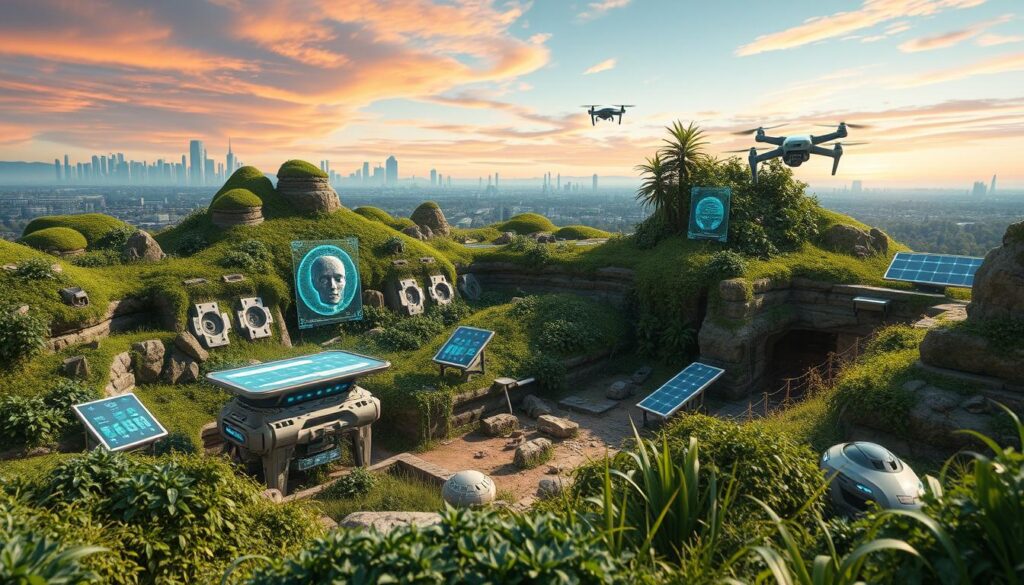

“The future of archaeology emphasizes a fact-driven, science-oriented, and collaborative approach, utilizing refined scientific techniques and introducing new capabilities for precise dating, analysis, and modeling.”
As we build our world, we create a legacy for future archaeologists. By knowing where and how to look, we can prepare for their discoveries. This will help us understand Futuristic Heritage Studies better.
The Influence of Globalization
Today’s fast-paced globalization has changed our world a lot. It has led to more sharing and sameness across the globe. This makes it hard for future archaeologists to tell different cultures apart.
Merging Cultures and Future Discoveries
Cultures blending together has created new, mixed artifacts. These items show the sharing of ideas and traditions. They will be key for archaeologists to grasp our complex global history.
The Value of Diverse Artifacts
In today’s world of cultural mix, saving different artifacts is key. These items show the rich variety of human societies. By keeping this heritage safe, we help future generations understand our global history.
As Cultural Heritage Preservation and Computational Anthropology grow, we’ll have better tools to study and save our artifacts. This will help archaeologists understand the complex mix of cultures and globalization in our world.
“The ability to negotiate status and control of resources was a significant factor in the interaction between cores and peripheries in ancient world-systems.”
By valuing diverse artifacts and using technology, we can leave a lasting legacy. This legacy will celebrate the depth of human experience and keep our story alive for future generations.
Ethical Considerations in Future Archaeology
As archaeology moves forward, it will face new ethical challenges. The rights of descendants and the balance between preserving sites and making progress will be key. Future archaeologists will have to carefully consider these issues.
The Rights of Descendants
Who gets to study and alter archaeological sites will become more complex. Future archaeologists must balance scientific research with respect for cultural heritage. This is especially true when working with descendant communities. The Principles of Archaeological Ethics by the Society for American Archaeology will guide them.
Preservation vs. Progress
Using new technologies, like , to recreate past societies will raise questions. Archaeologists will have to decide if scientific discovery is worth the risk to cultural heritage. Finding the right balance between preserving sites and advancing knowledge will be essential.
“The future of archaeology will require careful navigation of ethical dilemmas, where the rights of descendants and the preservation of cultural heritage must be balanced with the pursuit of scientific inquiry and technological advancements.”
The Digital Humanities will grow, and Anticipatory Analysis will become more crucial. It will help archaeologists think ahead and solve ethical problems. This way, they can protect and honor human history for future generations.
Lessons from Past Civilizations
Looking at ancient societies teaches us a lot about the rise and fall of civilizations. By studying the remains of past cultures, we learn about Techno-Cultural Evolution. This knowledge helps us predict the future and shows why we must keep our legacy alive for future generations.
What Ancient Societies Teach Us
The Aegean culture traded across 2,000 islands, and the Indus Valley Civilization had advanced transportation. The Shang dynasty passed leadership to the next generation, influencing future rulers. The Shang and Zhou dynasties in China showed how to mobilize thousands, a feat still studied today.
The Importance of Historical Awareness
Keeping the past alive through museums, archives, and libraries is key. This is especially important for groups like African Americans. Black History Month, started by Carter G. Woodson, challenges old stories and celebrates diverse cultures.
In today’s world, online archives and interactive sites let us explore history in new ways. By studying past civilizations, we learn about power, ideology, and social structure. This knowledge helps us predict the future and shape a better Techno-Cultural Evolution.
“Those who have no record of what their forebears have accomplished lose the inspiration which comes from the teaching of biography and history.”
– Carter G. Woodson
Conclusion: Our Legacy for the Future
Exploring Future Archaeology shows us that our actions will leave a lasting mark on Earth. Our cultural heritage and environmental impact will tell the story of our time to future archaeologists. This is a sobering thought.
Key Takeaways on Future Archaeology
Future Archaeology teaches us the value of preserving cultural artifacts and the role of technology in human evolution. It also emphasizes the importance of our environmental legacy. These insights help us create a legacy that future civilizations can learn from and be inspired by.
How We Can Shape Our Legacy Today
To leave a positive legacy, we need to adopt sustainable practices and develop technology ethically. Preserving cultural diversity is also crucial. By thinking about the long-term effects of our actions, we can ensure our story is one of triumph and learning for future generations.
Source Links
- https://humanorigins.si.edu/research/age-humans-evolutionary-perspectives-anthropocene
- https://news.uchicago.edu/origins-civilization-and-future-archaeology-day-tomorrow-began
- https://www.livescience.com/59115-year-million-series-explores-future-of-humanity.html
- https://link.springer.com/10.1007/978-3-319-51726-1_2792-1
- https://www.routledge.com/A-Future-for-Archaeology/Layton-Shennan-Stone/p/book/9781598743371?srsltid=AfmBOooanp7v9qMuzuRimgllUV_ZuISmKuCkmKlDjSJtzwvKft0KVFaz
- https://essaygenius.ai/essay/the-role-of-technology-in-archaeology
- https://www.sbt-durabi.org/articles/xml/Kz5Z/
- https://www.architectural-review.com/essays/future-archaeology-excavating-concealed-histories
- https://fpangoingpublic.blogspot.com/2019/10/archaeology-of-future-plastic.html
- https://medium.com/@struutinsky/archaeology-1000-years-from-now-75f62491a7eb
- https://www.phmc.state.pa.us/portal/communities/archaeology/resources/value-archaeology.html
- https://antigonejournal.com/2021/08/past-present-future-classical-archaeology/
- https://www.mdpi.com/2076-0787/2/2/128
- https://digitalcommons.lindenwood.edu/cgi/viewcontent.cgi?article=1689&context=faculty-research-papers
- https://popular-archaeology.com/article/exploring-the-roots-of-modern-human-behavior/
- https://humanorigins.si.edu/evidence/behavior
- https://pages.vassar.edu/realarchaeology/2022/12/04/the-effects-of-climate-change-on-archeology/
- https://archaeology.ncdcr.gov/programs/education-outreach/climate-change/predicting-effects
- https://radar.gesda.global/future-of-archaeology/
- https://www.captechu.edu/blog/how-ai-and-technology-is-revolutionizing-archeology
- https://researchoutreach.org/articles/archaeology-space-using-earth-observation-data-unearth-past/
- https://www.sociostudies.org/journal/files/jogs/2014_1/110-121.pdf
- https://www.oxfordbibliographies.com/abstract/document/obo-9780199766567/obo-9780199766567-0260.xml
- https://researchnow.flinders.edu.au/en/publications/global-archaeology
- https://www.saa.org/career-practice/ethics-in-archaeology
- https://link.springer.com/10.1007/978-1-4419-0465-2_283
- https://medium.com/@patrickstepanek/lessons-learned-from-ancient-ancestors-5cbab4e90c93
- https://thelostkingdoms.com/shaping-the-future-honoring-the-past-lessons-from-ancient-civilizations/
- https://www.bbc.com/future/article/20151127-how-will-future-archaeologists-study-us
- https://onezero.medium.com/the-high-tech-future-of-the-ancient-science-of-archaeology-391bf290efde
